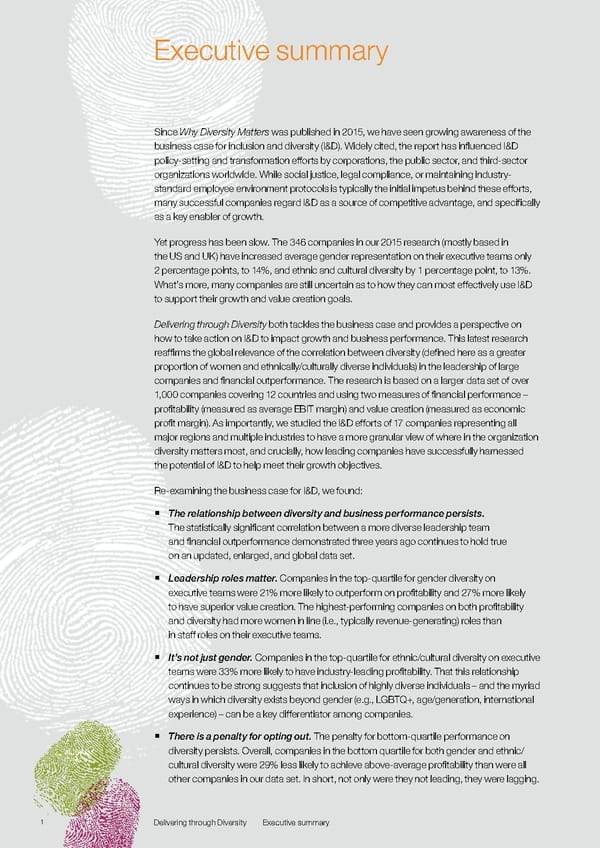Executive summary Since Why Diversity Matters was published in 2015, we have seen growing awareness of the business case for inclusion and diversity (I&D). Widely cited, the report has influenced I&D policy-setting and transformation efforts by corporations, the public sector, and third-sector organizations worldwide. While social justice, legal compliance, or maintaining industry- standard employee environment protocols is typically the initial impetus behind these efforts, many successful companies regard I&D as a source of competitive advantage, and specifically as a key enabler of growth. Yet progress has been slow. The 346 companies in our 2015 research (mostly based in the US and UK) have increased average gender representation on their executive teams only 2 percentage points, to 14%, and ethnic and cultural diversity by 1 percentage point, to 13%. What’s more, many companies are still uncertain as to how they can most effectively use I&D to support their growth and value creation goals. Delivering through Diversity both tackles the business case and provides a perspective on how to take action on I&D to impact growth and business performance. This latest research reaffirms the global relevance of the correlation between diversity (defined here as a greater proportion of women and ethnically/culturally diverse individuals) in the leadership of large companies and financial outperformance. The research is based on a larger data set of over 1,000 companies covering 12 countries and using two measures of financial performance – profitability (measured as average EBIT margin) and value creation (measured as economic profit margin). As importantly, we studied the I&D efforts of 17 companies representing all major regions and multiple industries to have a more granular view of where in the organization diversity matters most, and crucially, how leading companies have successfully harnessed the potential of I&D to help meet their growth objectives. Re-examining the business case for I&D, we found: ƒ The relationship between diversity and business performance persists. The statistically significant correlation between a more diverse leadership team and financial outperformance demonstrated three years ago continues to hold true on an updated, enlarged, and global data set. ƒ Leadership roles matter. Companies in the top-quartile for gender diversity on executive teams were 21% more likely to outperform on profitability and 27% more likely to have superior value creation. The highest-performing companies on both profitability and diversity had more women in line (i.e., typically revenue-generating) roles than in staff roles on their executive teams. ƒ It’s not just gender. Companies in the top-quartile for ethnic/cultural diversity on executive teams were 33% more likely to have industry-leading profitability. That this relationship continues to be strong suggests that inclusion of highly diverse individuals – and the myriad ways in which diversity exists beyond gender (e.g., LGBTQ+, age/generation, international experience) – can be a key differentiator among companies. ƒ There is a penalty for opting out. The penalty for bottom-quartile performance on diversity persists. Overall, companies in the bottom quartile for both gender and ethnic/ cultural diversity were 29% less likely to achieve above-average profitability than were all other companies in our data set. In short, not only were they not leading, they were lagging. 1 Delivering through Diversity Executive summary
 Delivering Through Diversity Page 2 Page 4
Delivering Through Diversity Page 2 Page 4